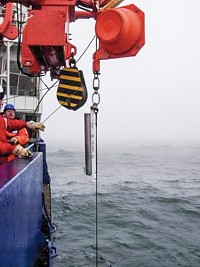Advertisement
Grab your lab coat. Let's get started
Welcome!
Welcome!
Create an account below to get 6 C&EN articles per month, receive newsletters and more - all free.
It seems this is your first time logging in online. Please enter the following information to continue.
As an ACS member you automatically get access to this site. All we need is few more details to create your reading experience.
Not you? Sign in with a different account.
Not you? Sign in with a different account.
ERROR 1
ERROR 1
ERROR 2
ERROR 2
ERROR 2
ERROR 2
ERROR 2
Password and Confirm password must match.
If you have an ACS member number, please enter it here so we can link this account to your membership. (optional)
ERROR 2
ACS values your privacy. By submitting your information, you are gaining access to C&EN and subscribing to our weekly newsletter. We use the information you provide to make your reading experience better, and we will never sell your data to third party members.
Environment
Floods can flush microplastic pollution from rivers into the sea
The largest survey ever of microplastics in freshwater suggests that scientists underestimate levels of the pollutants
by Katherine Bourzac
March 13, 2018
| A version of this story appeared in
Volume 96, Issue 12

Microplastic pollutants may be far more pervasive in lakes, streams, and oceans than previously estimated, according to the results of the largest survey yet of the particles in a freshwater system. The survey, conducted in the Manchester, England area, also showed that most of the plastic pollution originates in urban and suburban runoff and that extreme flooding can flush large quantities of the particles from rivers and into the sea (Nat. Geosci. 2018, DOI: 10.1038/s41561-018-0080-1).
Since the early 2000s, environmental scientists have studied the potential environmental effects of plastic microfibers, beads, and other fragments in the oceans. “There’s been much less attention on the terrestrial side of microplastics,” says Jamie Woodward, a physical geographer at the University of Manchester. “There’s hardly any data at all on microplastics in river systems.” In the absence of data, researchers have estimated that about 80% of marine microplastic comes from freshwater runoff. Other scientists have proposed that most of it comes from the breakdown of large pieces of plastic trash after they reach the ocean.
To try to get a more definitive answer on the sources of microplastics, Woodward wanted to perform a comprehensive, multiseason survey of all varieties of microplastics in an entire catchment area, which is a collection of rivers and streams that all drain into one body of water. In this case, the researchers looked at all ten of the rivers in the northwest of England that drain into the Irish Sea. Woodward and colleagues, Rachel Hurley and James Rothwell, sampled riverbed sediments at 40 sites in this densely populated area in the spring and summer of 2015.
Back in the lab, the researchers extracted microplastics from the sediment samples and used microscopy, infrared spectroscopy, and density-based extractions to classify the particles by size, shape, and composition. The team also determined whether the microplastics were buoyant in seawater, an indication that the particles could easily travel through the oceans.
The concentrations of different types of microplastics varied between areas in the catchment. For example, one site in the River Irwell was dominated by microbeads; downstream, microplastic fragments were prevalent. Closer to the center of the city of Manchester, microbeads dominated again. At a site on the River Tame, the team found about 517,000 particles per square meter—the highest concentration ever measured in freshwater.
In winter 2015, the Manchester area experienced record-breaking floods. So the team went back to their 40 sites and sampled again. “There was a vast reduction in microplastic levels” after the flood, Woodward says. Based on these comparisons and extrapolating for the entire catchment area, the researchers calculated that the floods likely flushed about 17 billion buoyant microplastic particles into the ocean.
Woodward believes that current models may be underestimating the concentration of microplastics in the world’s oceans. About half of the seawater-buoyant microplastic pieces found in the Manchester study were smaller than 300 µm wide, and would pass through the nets used for marine microplastic counting studies, he says. Also the microplastic load flushed into the ocean in just the one flooding event in England accounted for a significant portion, about 0.5%, of the estimated total number of microplastic particles in the world’s oceans, 4.85 trillion particles.
“This is the largest study of freshwater microplastics I’ve seen so far, and it demonstrates a massive contamination,” says Martin Wagner, an environmental toxicologist at the Norwegian University of Science and Technology.
Wagner says he would like to see more freshwater studies like the Manchester one, because the creatures that live in riverbed sediments can ingest these pollutants. They are not as beautiful as sea turtles, he says, but worms, waterfleas, and other creatures are ecologically important, too—and as bigger animals like fish eat the small ones, microplastics accumulate and move up the food chain. The environmental implications of this bioaccumulation are still not clear.
Woodward says this study, though local, has international implications. “I think anywhere you’ve got people and wastewater, you will have microplastics and urban contamination hotspots,” he says. The study will also allow scientists to track the effects of the U.K.’s ban on microbeads in cosmetics, which went into effect this year. “Now we can test whether the ban is having any impact,” on reducing microplastic contamination, he says.





Join the conversation
Contact the reporter
Submit a Letter to the Editor for publication
Engage with us on Twitter